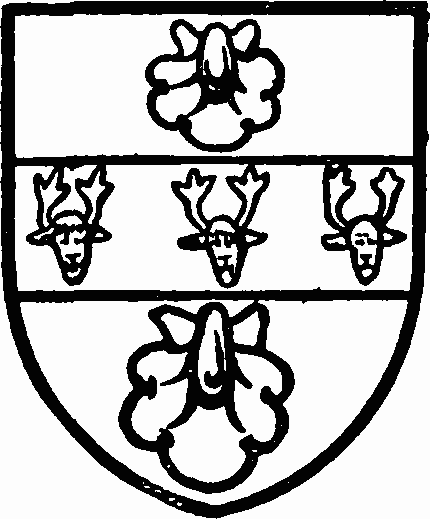A History of the County of Buckingham: Volume 4. Originally published by Victoria County History, London, 1927.
This free content was digitised by double rekeying. All rights reserved.
'Parishes : Luffield Abbey', in A History of the County of Buckingham: Volume 4, ed. William Page (London, 1927), British History Online https://prod.british-history.ac.uk/vch/bucks/vol4/pp197-198 [accessed 23 April 2025].
'Parishes : Luffield Abbey', in A History of the County of Buckingham: Volume 4. Edited by William Page (London, 1927), British History Online, accessed April 23, 2025, https://prod.british-history.ac.uk/vch/bucks/vol4/pp197-198.
"Parishes : Luffield Abbey". A History of the County of Buckingham: Volume 4. Ed. William Page (London, 1927), British History Online. Web. 23 April 2025. https://prod.british-history.ac.uk/vch/bucks/vol4/pp197-198.
In this section
LUFFIELD ABBEY
Luffield covers 216 acres, two-thirds of which are devoted to pasture and one-third to arable land. (fn. 1) The soil is clay and gravel and the subsoil various. Luffield was formerly extra-parochial, (fn. 2) and considered partly in Buckinghamshire, where it was assessed under Stowe (fn. 3) (whose boundaries do not, however, touch it at any point), and partly in Silverstone in Northamptonshire, where the monastic church formerly stood. (fn. 4) In 1831 its area was given as 450 acres, of which 60 lay in Northamptonshire. (fn. 5)
In 1881 it was still reckoned as extra-parochial, (fn. 6) but is now rated as a parish extending into both counties. It is still reputed to be extra-parochial for ecclesiastical purposes. The parish consists of a single farm, of which the house occupied in 1831 by the whole population, a family of ten persons, (fn. 7) is situated to the north-east, on the site of the old priory. No traces now remain of the former conventual buildings, and even Willis, who visited Luffield on 11 October 1732, found only a piece of the old tower of the church, from which he deduced the supposed dimensions of the church, 80 ft. in length and 30 ft. in breadth. (fn. 8)
Manor
The history of the Benedictine priory of LUFFIELD down to its acquisition by Westminster Abbey has already been traced elsewhere. (fn. 9) The grant of Luffield Priory, manor and advowson to the abbey was confirmed in 1503, (fn. 10) and the abbot appears to have leased the estate almost immediately to Sir Richard Empson for forty years. (fn. 11) On his attainder a lease for thirty-four years was granted to William Tyler in 1512, with the site and demesne of the priory and lands in Luffield, the chapel of St. Thomas the Martyr in Lillingstone Dayrell and the chapel of St. Nicholas in Evershaw, Biddlesden. (fn. 12) At the Dissolution Luffield became Crown property, and as such was attached to the honour of Grafton formed in 1542. (fn. 13) In 1551 the manor and site were granted to Sir Nicholas Throckmorton, (fn. 14) whose second son Arthur Throckmorton (fn. 15) settled the estate by fine in 1580, (fn. 16) and again in 1582, (fn. 17) 1596, (fn. 18) and 1614. (fn. 19) Sir Arthur, who died in 1626, had four daughters, of whom the second, Ann, married Sir Peter Temple of Stowe. (fn. 20) She had died in January 1619–20, leaving a daughter and heir Ann, who, after the death of her father in 1653, (fn. 21) Made a settlement of Luffield with her husband Thomas Roper, Viscount Baltinglass. (fn. 22) They were sued for debt in 1658 by Clement Throckmorton and others, who complained that a secret conveyance of Luffield prevented the recovery of the money, and were confined in the Fleet Prison, (fn. 23) where Ann died in 1696. (fn. 24) A quarrel arose over her inheritance, which included Thornborough (q.v.), between William Temple, of Lillingstone Dayrell, her first cousin once removed on her father's side, (fn. 25) and Thomas Lennard, Lord Dacre and Earl of Sussex, her first cousin once removed on her mother's side, (fn. 26) the grandson of Sir Arthur Throckmorton's third daughter Elizabeth. (fn. 27) In the final division of the property in 1701 Luffield was allotted to William Temple. (fn. 28) His son and heir William Temple, who inherited the manor in 1706, (fn. 29) gave up his rights in it in 1718 to his cousin Sir Richard Temple, bart., of Stowe, Lord Cobham of Cobham, whom he afterwards succeeded in the baronetcy. (fn. 30) It descended with Stowe (q.v.), to which it was still attached in the mid19th century (fn. 31); but the manorial rights are now vested in Sir Edmund Giles Loder, bart., of Leonardslee, Horsham, Sussex, the sole landowner.

Loder. Azure a fesse between two scallops or with three harts heads caboshed proper upon the fesse.
In 1230 the prior and monks received a grant of a yearly fair on the feast of the Exaltation of the Holy Cross, (fn. 32) of which no mention has been found after 1330. (fn. 33)
There do not appear to be any endowed charities subsisting in this parish.